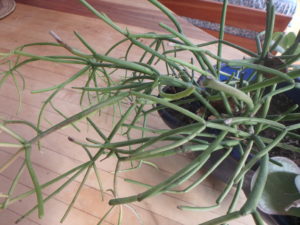Tips for Growing House Plants
Even the best vegetable gardener can struggle to keep house plants alive. A champion rose gardener sometimes kills her fiddle-leafed fig or “mother-in-law’s tongue” (also called the snake plant or Sansevieria). Why? Because the growing conditions are really very different. And indoors plants really do depend on us to keep them alive much more than outdoor plants.
I recently received a review copy of a new book from Button Street Press, Don’t Repot That Plant and Other Indoor Plant Care Mistakes by Will Creed. Creed has 35 years of professional experience caring for indoor plants for businesses and homes in New York City, and has been answering questions on-line and on the phone for many years. I like the book, and learned from it.
Creed starts out by explaining that most houseplants do not need to be re-potted very often, that most thrive with roots that are crowded in a pot. His test for re-potting is based on how long it takes for the soil medium to dry out after a good watering. If the plant dries out in less than three days, it’s time to re-pot. He points out that it takes years for a plant to use up the minerals in a soil mix, and an occasional application of fertilizer is usually better than (and easier than) re-potting.
When re-potting you only want to step up one pot size, so choose a pot that is about an inch wider at the top than the existing pot. Creed suggests watering a plant well 24 hours before re-potting – a trick I did not know.
Select a potting mix that is suitable for your particular type of plant. Orchids, for example, need a very loose material with large chunks of bark. A cactus soil needs a sandy mix, and many plants do well with a peat-based mix. Try to match what the plants came with. Various potting mixes are sold at garden centers.
Creed warns against putting pebbles or pot shards at the bottom of the pot, a practice that was common in the past. Add about an inch of new soil mix in the bottom of the pot, but never any on the top of the root ball. Using your fingers or a table fork, push new material down along the sides of the root ball, and water the mixture in. Never pack it too tightly.
Most houseplant owners understand that too much water will kill potted plants. Why? Two reasons: 1. Roots that are constantly wet are prone to rot, and 2. Soggy soil doesn’t allow roots to get oxygen. That’s right, green plants do not get their oxygen through their leaves, but from their roots. Too much water can drown a plant.
For many houseplants a once-a-week watering that reaches the bottom of the pot and leaks out a little is just right. Keep your houseplant in a saucer or on a plate, but never let it sit in water.
Creed does not like the technique of using ice cubes as a water source. Yes, they melt slowly and allow water to be absorbed, but rarely will you see water drip out of the pot – his test to see if water has reached the roots at the bottom of the pot. And although there are moisture meters, he does not recommend them either. They can be inaccurate if you use fertilizer, or if you have hard water. A finger poked into the soil is his preferred method for testing moisture levels.
Another factor for success with houseplants is to know how much light a plant needs. Many house plants are tropicals that are shade plants in their native habitat. I remember hiking through the jungle in Cameroon where the light levels were so low that even on a sunny day my camera required a flash!
Creed defines the various indoor light levels carefully and gives examples of plants that thrive in each category. Generally, of course, the plant tag will tell you if a plants needs indirect bright light, direct light in a south –facing window, or low light. He says if you can’t read a newspaper in the light you have, you can’t grow any plant there!
If you aren’t attentive to house plants, you want low-light plants. Creed says “Plants in low light must be neglected. Do not repot them; don’t fertilize them; and let the soil become quite dry before watering. Remember the needs of low light plants are minimal.” What are some low light plants? Heart-leafed philodendron, various Dracaena, peace plant (Spathiphyllum) and cast iron plant (Aspidistra).
Fertilizer is another mystery for many houseplant owners. Creed’s rule? Less – or none- is generally better. Always dilute the fertilizer to half the recommended amount. He explains that plants need more nutrients when they are in a growth spurt, not when they are sick or relatively dormant. Don’t think that fertilizer will fix what’s wrong with your plants. Adjusting light or watering patterns is more likely to help them. I know, for example, to give my rosemary plants more water in the spring to avoid losing them.
In addition to chapters on all the topics above, Creed’s book includes chapters on many good indoor plants, complete with photos. So if you’re having trouble with your plants, you might want to check out this book.
Read Henry’s blog at https://dailyuv.com/




